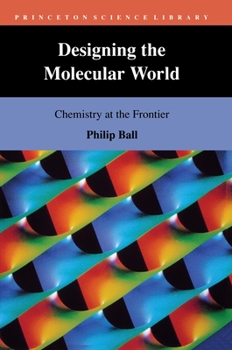Designing the Molecular World: Chemistry at the Frontier
Select Format
Select Condition 
Book Overview
Some of the most exciting scientific developments in recent years have come not from theoretical physicists, astronomers, or molecular biologists but instead from the chemistry lab. Chemists have created superconducting ceramics for brain scanners, designed liquid crystal flat screens for televisions and watch displays, and made fabrics that change color while you wear them. They have fashioned metals from plastics, drugs from crude oil, and have...
Format:Paperback
Language:English
ISBN:0691029008
ISBN13:9780691029009
Release Date:November 1996
Publisher:Princeton University Press
Length:384 Pages
Weight:1.32 lbs.
Dimensions:0.9" x 6.2" x 9.3"
Customer Reviews
5 ratings
Designing the Molecular World
Published by Thriftbooks.com User , 15 years ago
This is the best overview of chemistry that I have found. It can be read by senior chemistry majors and older chemists who want to know what has occurred up to the time of its publication. It should be revised to include the developments from the 1990s and 2000s. Freshman chemistry majors might read this to help fire their imaginations. Ditto organic and biochemistry students.
Learning Chemistry is fun!
Published by Thriftbooks.com User , 16 years ago
This is first off a well written book and then a book about Chemistry and molecules. Philip Ball clearly believes that what goes on in the molecular world is not that difficult to understand, though it's usually cloaked with confusing Latin names, and he proves it by explaining it all. Reading this book makes me feel smart. Here's a sample sentence from page 78 of the paperback edition: "As natural chiral molecules are the result of enzyme-mediated biochemical processes, it is clear that enzymes must have an extraordinarily efficient capacity for distinguishing between different enantiomers; in other words they show a high degree of enantiospecificity." After reading that I realized that I completely understood what it meant because all those big words are referring to easily understood processes or things which are clearly explained. I am now excited about Chemistry and want to learn more. I am very grateful to find books like this one to feed my hungry mind.
Excellent, thorough, and thought provoking
Published by Thriftbooks.com User , 18 years ago
Odd to say that a book published in 1994 is still relevant but the frontiers of science are pushed out so quickly that is always a good to wonder about. Ball's book is well written and thorough but at times can drag on a bit. Some level of understanding of college level chemistry will be helpful but not necessary. I'm a biologist at heart but chemistry - especially this kind of chemistry - always fascinates me. This is the realm of tinker toys on the molecular level. Reading the book makes chemistry exciting - why should the physicists have all the fun? Ball shows how chemistry is being used to make new kinds of materials that have great impact on everyday living. He gives excellent explanations of technique and the historical context of the present work. There's a lot here but it's well worth it.
A fantastic review of or introduction to molecular design
Published by Thriftbooks.com User , 22 years ago
When looking for detailed, specific information about nanotechnology, I stumbled across this book. At that time, I knew that there was a link between chemistry and nanotechnology, but was having trouble finding chemistry books that made sense from a molecular engineering (nanotechnology) point of view.I rarely read technical books from cover to cover, but this one was so engaging and covered so many topics that I actually WANTED to learn more about that I found I could not put it down. Most chemistry books seem to be focused on bulk properties of broad classes of chemical compounds (i.e. "When compounds of class A are mixed with compounds of class B, the result is typically compounds of classes D and E). This was the only popular book I found that day that specifically discussed atomic and molecular processes from an ATOMIC level.After reading the book, I found myself reading complex technical articles with surprising ease and understanding terminology that I otherwise would not have recognized, though I might have been exposed to it in college.The end of the book contains several chapters describing the author's particular views about the origins of life and the universe, and about various environmental crises with a noticeable, but not overriding, disdain for certain other points of view. I appreciated that the author shared his opinions on these matters, but also kept them to the end and clearly separated from the rest of the book. This section is still engaging and presents interesting points of view.This book combines historical stories and anecdotes with explanations of traditional chemistry to show how "chemistry" has changed and how it has spawned the new field of molecular engineering (popularly known as Nanotechnology), related to but distinct from chemical engineering.
A fascinating update on a neglected area
Published by Thriftbooks.com User , 24 years ago
The author contends that physics and astronomy get all the public attention these days, to the neglect of chemistry, yet advances in this field have more real impact on our lives. The most interesting parts of this book show how we are adapting biochemistry, such as enzymes, to everyday production of useful chemical resources. The book is written at the level of the "old" Scientific American, with plenty of real science and less of the "gee-whiz" of other popularizations. Thankfully, there is little need for math here, but read the first section carefully, where he explains the basic physics of molecules, which is central to the rest of the book. I enjoyed it thoroughly and it really brought this reader, who had his last chemistry in 1961, up to speed on chemistry today.





